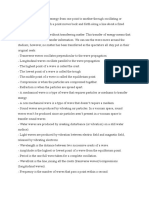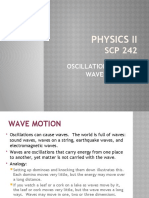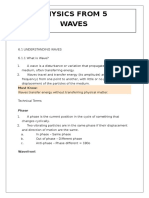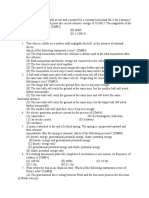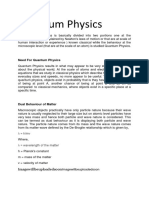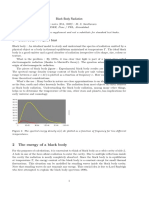Waves: Carriers of Energy
Waves: Carriers of Energy
Uploaded by
littlepenguinCopyright:
Available Formats
Waves: Carriers of Energy
Waves: Carriers of Energy
Uploaded by
littlepenguinOriginal Description:
Original Title
Copyright
Available Formats
Share this document
Did you find this document useful?
Is this content inappropriate?
Copyright:
Available Formats
Waves: Carriers of Energy
Waves: Carriers of Energy
Uploaded by
littlepenguinCopyright:
Available Formats
WAVES: CARRIERS OF ENERGY
Definition
1. Wave is a disturbance that carries energy through matter or
space; pulses traveling at regular intervals
2. Medium the matter through which a wave travels
3. Pulse disturbance in the medium
Types of Waves according to Medium
1. Mechanical Waves require a medium
2. Electromagnetic Waves do not require a medium
Types of Waves according to the Number of Pulse
1. Pulse Wave consists of a single traveling pulse
2. Periodic Waves consist of pulses
Types of Waves according to Movement
1. Transverse Wave vibrations are at a right angle or
perpendicular to the direction of the wave (e.g., light waves and
other electromagnetic waves)
a. crest highest point
b. through lowest point
2. Longitudinal Wave the vibrations are along the direction of
the wave (e.g., sound waves)
a. compression region where the coil are pressed together
b. rarefaction- region where the coils spread out
3. Surface Wave combination of transverse and longitudinal
waves (e.g., water waves)
Measures of a Wave
1. Waveform a picture or graph of a wave
2. Amplitude displacement of particles of the medium from the
equilibrium position
a. The height of the crests and the troughs is equal to the
amplitude of the wave.
b. The amplitude depends on the amount of energy the wave is
carrying.
3. Wavelength distance between neighboring maximum
displacements; distance between two successive crests and
troughs or between two successive compressions or rarefactions
WAVE PROPERTIES AND INTERACTIONS
Reflection bouncing of waves on a surface with angle to the
normal.
1.
2.
3.
4.
incident ray ray that hits the barrier
reflected ray ray that is thrown back
normal line perpendicular to the reflecting surface
angle of incidence angle formed by the incident ray with the
normal
5. angle of reflection angle formed by the reflected ray with the
normal
Law of Reflection
1. The angle of incidence is equal to the angle of reflection.
2. The incident ray, the reflected ray and the normal lie on a single
plane.
Examples:
1. Sound waves can bounce back as echoes from a wall.
2. Light waves may be reflected by smooth surface such as a mirror.
3. Radio waves are reflected by the ionosphere.
4. The moon reflects light from the sun.
Refraction bending of waves as they pass from one medium to
another
1. The bending is due to a change in speed as it passes from one
medium to another medium of different density.
2. The principle of refraction gives rise to apparent distortion of
objects submerged in water.
3. Water waves travel slower in shallow water than in deep water.
4. When the waves are moving from deep to shallow water, the
angle of incidence is greater than the angle of refraction.
5. When the waves are moving from shallow to deep water, the
angle of incidence is smaller than the angle of refraction.
6. If a wave slows down just after passing the boundary between
two media, the angle of refraction is less than the angle of
incidence. If the wave speeds up, the angle of refraction is
greater than the angle of incidence.
Diffraction bending of edge or corner as they pass an edge or
corner
1. The amount of diffraction is dependent on the wavelength and
size of the opening barrier.
2. Diffraction is only significant if the size of the opening is about
the size of the wavelength.
3. Larger opening produce less diffraction.
Interference and Superposition
1. Interference interaction that occurs when two waves meet
2. Superposition Principle when two waves meet while
traveling through a medium at the same time, the result is a
wave whose displacement is equal to the vector sum if the
displacement of the two waves
Two Types of Interference
1. Constructive the crest of one wave meets the crests of other
waves, and the troughs of one wave meets the other; the
amplitude of the resulting wave will be twice the original wave
2. Destructive the crests of one wave meet the troughs of the
other; the amplitude of the resulting wave is zero
Standing Waves and Natural Frequency
1. Standing/Stationary Waves result from the interference of
waves of identical wavelength, amplitude and speed traveling in
opposite directions
a. node point on the standing wave that always undergoes
destructive interference and with zero amplitude
b. antinode point halfway between two nodes at which the
maximum amplitude occurs
2. Natural/Resonant Frequencies frequencies at which large
amplitude standing waves are produced
Examples:
string
plucking a guitar, bowing a violin, striking piano
---THE END---
You might also like
- Ripple Tank GizmosDocument8 pagesRipple Tank GizmosWlr DiorNo ratings yet
- 0909 Dut 92Document99 pages0909 Dut 92ramia_30No ratings yet
- Waves: Ivan L. Saligumba Institute of Education and Teacher TrainingDocument40 pagesWaves: Ivan L. Saligumba Institute of Education and Teacher TrainingGellirose S. Bantayan100% (1)
- Chapter SevenDocument10 pagesChapter Sevensaed cabdiNo ratings yet
- Lesson 16. Wave MotionDocument44 pagesLesson 16. Wave Motionjonathangrizzle231No ratings yet
- Clem Waves Lesson02 Notes As PDFDocument1 pageClem Waves Lesson02 Notes As PDFRusherNo ratings yet
- G-9 Unit 8Document73 pagesG-9 Unit 8Garamu NamaraNo ratings yet
- Physics NotesDocument6 pagesPhysics NotesLegend RR3No ratings yet
- Presentation On WavesDocument7 pagesPresentation On Wavesmaqsood ahmadNo ratings yet
- Physics II - WavesDocument15 pagesPhysics II - WavesVicky Waran RajNo ratings yet
- IGCSE Waves NotesDocument27 pagesIGCSE Waves Noteshasnizaaziz39No ratings yet
- WavesDocument21 pagesWavesTintinententen Christine TintinNo ratings yet
- Booklet About WavesDocument25 pagesBooklet About Wavesshiri.hasanNo ratings yet
- WavesDocument52 pagesWavesapi-508592459100% (1)
- Handouts in ScieDocument1 pageHandouts in ScieJonel BarrugaNo ratings yet
- Lecture 1 Biophysics IIDocument9 pagesLecture 1 Biophysics IIMohamed AshmawyNo ratings yet
- Waves PowerPointDocument97 pagesWaves PowerPointAirene Mariel MagbanuaNo ratings yet
- Wave Reflection Refraction and DiffractionDocument8 pagesWave Reflection Refraction and Diffractionapi-449002661No ratings yet
- Physics Form 5 Chapter 1Document39 pagesPhysics Form 5 Chapter 1Leong Laichuo40% (5)
- Physics Lecture Note On U-8Document116 pagesPhysics Lecture Note On U-8tifshitzelealemNo ratings yet
- Waves and SoundDocument11 pagesWaves and SoundArebeeJayBelloNo ratings yet
- General Physics 2 Module 3 My AnswersDocument3 pagesGeneral Physics 2 Module 3 My AnswersMatth N. ErejerNo ratings yet
- The Nature and Properties of Waves and Seismic WavesDocument8 pagesThe Nature and Properties of Waves and Seismic WavesDanika Mae SoberanoNo ratings yet
- Wave Foldable NotesDocument25 pagesWave Foldable Notescwqcvd4py5No ratings yet
- Waves: Lecture 1 (2 Week) Prepared By: Muhammad Saiful Badri MansorDocument18 pagesWaves: Lecture 1 (2 Week) Prepared By: Muhammad Saiful Badri MansorNor HusnaNo ratings yet
- Waves IDocument33 pagesWaves IMd. Ibrahim Sani 2211043642No ratings yet
- WavesDocument4 pagesWavesJohn Adrian RoqueNo ratings yet
- WaveDocument14 pagesWaveLitiaMikoNo ratings yet
- Waves IntroDocument10 pagesWaves Introgenie lagunayNo ratings yet
- Waves PowerPointDocument97 pagesWaves PowerPointkeishalorenzo13No ratings yet
- WavesDocument52 pagesWavesapi-245497801No ratings yet
- PhysicsDocument8 pagesPhysicsHeather SimpsonNo ratings yet
- Waves (Physics)Document55 pagesWaves (Physics)Chloe Huang100% (1)
- FileDocument24 pagesFileewnwzpmjwkNo ratings yet
- 10th Class Physics by ShakeelDocument123 pages10th Class Physics by ShakeelShakeel lodhiNo ratings yet
- Physics Notes-WAVESDocument18 pagesPhysics Notes-WAVESAromaNo ratings yet
- Waves: Wave MotionDocument11 pagesWaves: Wave MotionSukhman MannNo ratings yet
- Unit 1 LESSON 1 2Document8 pagesUnit 1 LESSON 1 2kachechiekurosakiNo ratings yet
- Physic Notes DefinitionsDocument5 pagesPhysic Notes Definitionsfatimawaqar657No ratings yet
- Aqa A Level Physics Required PracticalsDocument8 pagesAqa A Level Physics Required PracticalsLouisNo ratings yet
- Oscillation: Online Learning Resources For Malaysia StudentsDocument0 pagesOscillation: Online Learning Resources For Malaysia StudentsJia HuiNo ratings yet
- Waves 100Document6 pagesWaves 100Brook Rene JohnsonNo ratings yet
- Notes On Interference N Diffraction of WavesDocument10 pagesNotes On Interference N Diffraction of WavesHubbak KhanNo ratings yet
- WAVES Chapter 9Document8 pagesWAVES Chapter 9shasagailNo ratings yet
- Holy Angel Corporation Caloocan CityDocument9 pagesHoly Angel Corporation Caloocan CityZyrrus Salandanan VargasNo ratings yet
- ch11 2Document90 pagesch11 2tara.jojiNo ratings yet
- Aswavesnotes 2Document6 pagesAswavesnotes 2matthewbennett.erazorNo ratings yet
- Waves sc7 1 1Document77 pagesWaves sc7 1 1uy.cuencosultanNo ratings yet
- Wave Properties AND InteractionsDocument40 pagesWave Properties AND InteractionsRachelleOiguelShakiraNo ratings yet
- Waves and Sound: Wave CharacteristicsDocument51 pagesWaves and Sound: Wave CharacteristicsAditya MahadevanNo ratings yet
- Physics 1 WaveDocument9 pagesPhysics 1 WaveKavi VityaNo ratings yet
- For Reporting Waves PowerPoint 1Document117 pagesFor Reporting Waves PowerPoint 1Laly AracielNo ratings yet
- An Introduction To WaveDocument9 pagesAn Introduction To WaveOyeladun IdrisNo ratings yet
- Wave HandoutDocument2 pagesWave HandoutBridget CumlatNo ratings yet
- Different Types of WavesDocument4 pagesDifferent Types of Waveselladionisio01No ratings yet
- Physics 4 PDFDocument122 pagesPhysics 4 PDFBABU JOHNNo ratings yet
- Waves and Optics Class Notes Part 1Document3 pagesWaves and Optics Class Notes Part 1reeta ramNo ratings yet
- Wave 25 November 2021Document41 pagesWave 25 November 2021Ulfa Mahfudli FadliNo ratings yet
- How Do Waves Behave? How Are They Measured? Physics Lessons for Kids | Children's Physics BooksFrom EverandHow Do Waves Behave? How Are They Measured? Physics Lessons for Kids | Children's Physics BooksNo ratings yet
- Maxwell's Equations and the Principles of Electromagnetic PhenomenaFrom EverandMaxwell's Equations and the Principles of Electromagnetic PhenomenaNo ratings yet
- 8.2 Waves-NewDocument61 pages8.2 Waves-Newchowdhury jumainaNo ratings yet
- TANCET ME (Basic Engineering & Sciences) - Basic - Engg - and - SciencesDocument4 pagesTANCET ME (Basic Engineering & Sciences) - Basic - Engg - and - Sciencesrameshdurairaj81% (16)
- KaplanDocument43 pagesKaplanKamran AliNo ratings yet
- Wave On A String Phet LabDocument5 pagesWave On A String Phet LabNicholas BarresiNo ratings yet
- Quantum PhysicsDocument3 pagesQuantum Physicsaashhs kechuoNo ratings yet
- Physics Week4Document7 pagesPhysics Week4brylla monteroNo ratings yet
- BPHCT 137Document8 pagesBPHCT 137Njaan SnehamaakunnuNo ratings yet
- Astronomy Assignment 1Document2 pagesAstronomy Assignment 1Mark MoloneyNo ratings yet
- General Physics 1: Quarter 2 - Module 3 Periodic MotionDocument32 pagesGeneral Physics 1: Quarter 2 - Module 3 Periodic MotionCHELCEE C. ENARIO100% (1)
- 130 FT End Fed Half Wave - Multiband OperationDocument1 page130 FT End Fed Half Wave - Multiband OperationToplician AdrianNo ratings yet
- Wavelength, Frequency, Speed & Energy WorksheetDocument1 pageWavelength, Frequency, Speed & Energy WorksheetAhnaf Rahman100% (1)
- FZS1BDocument6 pagesFZS1BSuhami Ibrahim0% (1)
- InterferenceDocument19 pagesInterferenceMuhammad AliNo ratings yet
- DPP 2 Waves On StringDocument3 pagesDPP 2 Waves On Stringupanshupandit3No ratings yet
- Yamanouchi Quantum Mechanics Molecular StructuresDocument276 pagesYamanouchi Quantum Mechanics Molecular Structuresleendert_hayen710750% (2)
- 205744Document90 pages205744dcf67myNo ratings yet
- 일반물리학 7판 35장Document11 pages일반물리학 7판 35장jhe0316No ratings yet
- Notes On Black BodyDocument5 pagesNotes On Black BodyHamza HanifNo ratings yet
- Leaky CableDocument5 pagesLeaky CableMaryanna DellaNo ratings yet
- Q3 Summative Test 1,2 3 PDFDocument8 pagesQ3 Summative Test 1,2 3 PDFZDMon TVNo ratings yet
- Books Doubtnut Question BankDocument562 pagesBooks Doubtnut Question Bankssp307317No ratings yet
- Fiber Optics Ece Board ExamDocument7 pagesFiber Optics Ece Board ExamSharon CarilloNo ratings yet
- Messer2018 002 PDFDocument3 pagesMesser2018 002 PDFPWA TuzlaNo ratings yet
- X-Ray DiffractionDocument30 pagesX-Ray DiffractionMerve Ayvaz KöroğluNo ratings yet
- Aspect Et Al - PRL'82 - Experimental Test of Bell's Inequalities Using Time-Varying Analyzers PDFDocument4 pagesAspect Et Al - PRL'82 - Experimental Test of Bell's Inequalities Using Time-Varying Analyzers PDFpkonigNo ratings yet
- Simak Ui Kki Per BabDocument6 pagesSimak Ui Kki Per BabNgIa MaStaNo ratings yet
- Microwave Optics: Reader Electrical Engineering, University College, London, EnglandDocument46 pagesMicrowave Optics: Reader Electrical Engineering, University College, London, EnglandOmar HraouiNo ratings yet
- 5.determination of Laser Parameters - Wave Length and Particle SizeDocument7 pages5.determination of Laser Parameters - Wave Length and Particle SizeSrinivas SrinivasNo ratings yet







